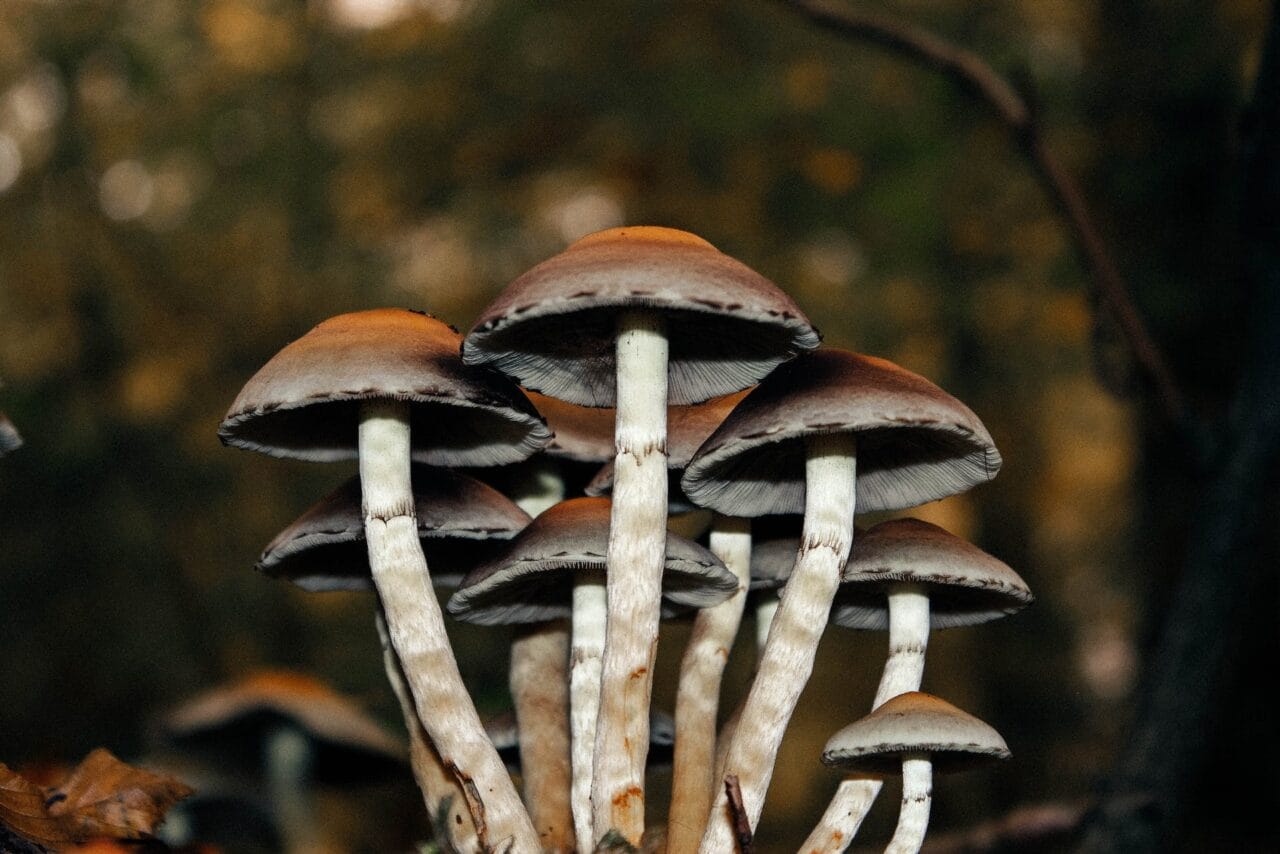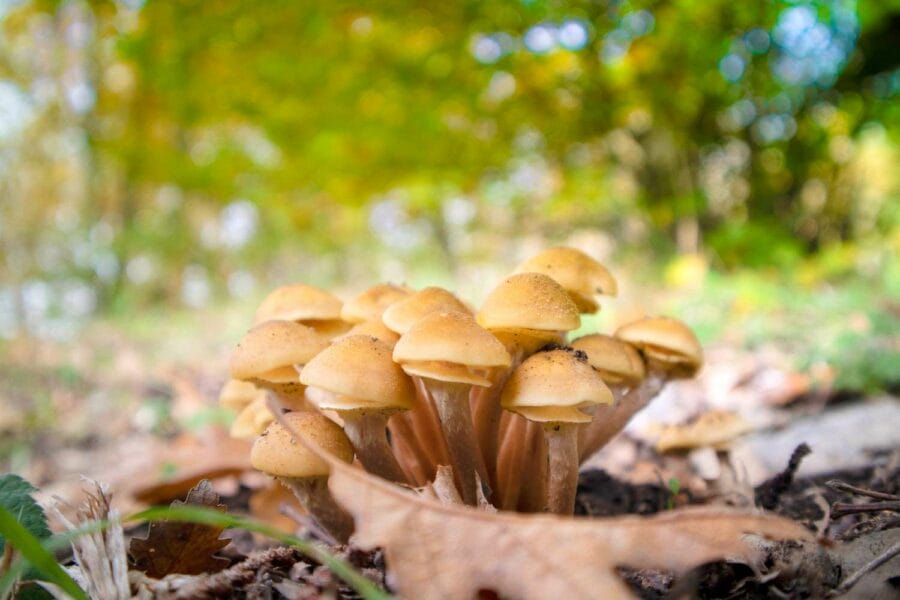Psilocybin, a psychoactive compound typically found in magic mushrooms, is frequently used recreationally to induce euphoria and hallucinations.
In addition to its mind-altering properties, psilocybin has been studied for its potential benefits in managing chronic pain.
This article discusses a case study that investigates the potential of microdosing mushrooms in alleviating chronic pain.
Key Takeaways:
- Microdosing mushrooms might provide both immediate and sustained pain relief.
- When compared to traditional pain medications, microdosing psilocybin typically has fewer side effects if given in small quantities.
- Psilocybin interacts with serotonin 2A (5-HT2A) receptors, which can help alleviate pain and other conditions.

The Research
The research paper “Microdosing Psilocybin for Chronic Pain: A Case Series” was carried out by Dr. Matthew Lyes and his team from the University of California, San Diego’s Division of Pain Medicine in the Department of Anesthesiology. Their study focused on three patients who self-medicated with small doses of psilocybin to manage their chronic pain symptoms.
Three Patients, One Result – Relief from Chronic Pain
Patient # 1
| AGE/ GENDER: | 37 Male |
| TYPE OF PAIN: | Neuropathic pain occurring below a spinal cord injury site. |
| PAIN LEVEL: | Initially ranging from 4 to 5 out of 10, but increasing to 8 out of 10 later in the day |
| PSILOCYBIN DOSE: | 250 mg of ground mushroom for less than 6 months |
| RESULT: | Discontinuation of prescribed pain medication, decrease in muscle spasms, and improved bowel movement regularity. No signs of rebound pain or withdrawal symptoms were observed. |
| The patient reported that unlike his regular medications, which only managed to dull the pain, psilocybin effectively eliminated it, reducing his average pain level from 5 to 0. | |
Case Study: Subject #2
| AGE/GENDER: | 69-year-old female |
| PAIN TYPE: | Complex Regional Pain Syndrome (CRPS) |
| PAIN INTENSITY: | Typically varies between 5 and 7 out of 10, but increases with physical activity and during pain flare-ups |
| DOSAGE OF PSILOCYBIN: | Regular consumption of 500 mg daily for 7 to 10 days with breaks (2 to 3 days) over one year. Dosage rises to 750 mg to 1 gram during pain flare-ups |
| RESULTS: | Pain is reduced by 80% for 3-4 hours, slowly returning to initial levels after 12 hours. Complete pain relief (90%-100%) persists for 6-8 hours, reverting to original levels after 18 hours. |
| The subject reports decreased appetite without nausea. An increase in disorientation or unsteadiness while walking is observed when the dosage is raised (750 to 1000mg). | |
Case Study: Subject # 3
| AGE/GENDER: | 40-year-old female |
| PAIN TYPE: | Lumbar radiculopathy and neuropathic pain |
| PAIN INTENSITY: | Rated 8 out of 10, increasing to 10 during physical activities |
| DOSAGE OF PSILOCYBIN: | 1000 mg from a chocolate bar infused with mushrooms every two months. |
| RESULTS: | Significant relief from pain without any psychoactive side effects. Notable improvements in flexibility and mobility. Pain slowly reverts to initial levels over a period of 2-4 weeks. Repeated dosing enhances pain control. |
| The subject does not experience any obvious physical, cognitive, or behavioural side effects. Her mood remains predominantly stable. She continues her regular SSRI dosage for managing depression throughout the psilocybin treatment period. | |
Understanding the Role of Psilocybin in Pain Management
Constant somatic and visceral pain signals fortify certain neural pathways due to peripheral and central sensitisation, resulting in a chronic perception of pain, both physically and emotionally. Psychedelics like psilocybin activate 5-HT2A receptors, potentially resetting the brain regions associated with neuropathic conditions.
One patient experienced sustained pain relief for several weeks. This suggests that after directly stimulating the 5-HT2A receptors, there may be a central regulation of pain perception and
Adaptability of synapses.
Potential Side Effects: Comparing Psilocybin with Traditional Pain Relievers
| PSILOCYBIN (Based on Research) | TRADITIONAL PAIN RELIEVERS |
| Muscle spasms | Nausea |
| Diminished appetite | Discomfort in the abdomen |
| Confusion | Headaches |
| Impaired gait | Dependency |
| No change in mood | Drowsiness |
Prospective Future Investigation on Psilocybin
The research team, as a result of studying three individual cases, has indicated specific research areas that might merit additional investigation due to their potential benefits.
- Small psilocybin doses could provide immediate and possible long-lasting relief from neuropathic pain, without causing physical tolerance or addiction.
- Examine the outcomes of various therapeutic approaches in conjunction with psilocybin. For example, patient #3 reported an increased pain-relieving effect when psilocybin was combined with physical therapy.
- Pain relief might be possible with small psilocybin doses, even without psychotherapy, as suggested by this case study. The integration of therapeutic guidance could potentially enhance or extend the therapeutic outcomes.
Constraints of the Study
While the findings appear promising, it is essential to acknowledge the limitations identified in the study.
- The limited sample size might not accurately reflect the experiences of all individuals living with neuropathic pain.
- Individuals who did not respond to psilocybin were not included in the study.
- No assessments were conducted before and after treatment to evaluate the impact of psilocybin on psychiatric conditions such as depression and anxiety.
- Most of the data was self-reported by the participants.
- The presence of the interviewer and potential bias related to psilocybin could have influenced participants’ responses.
- The study did not examine the potential influence of the placebo effect.
- The amount of psilocybin present in each mushroom was not determined by the study.
Microdosing Psilocybin Mushrooms
In this study, Patients #1 and #2 consumed a microdose of psilocybin in its powdered form obtained from dried mushrooms, while Patient #3 combined it with chocolate. There exists a variety of products designed specifically for psilocybin microdosing, and we’ve gathered a selection of them below.
Dehydrated Mushrooms
Although the study didn’t mention the exact strain used, the strain below is recommended for those new to microdosing.
- Golden Teacher: A commonly found and widely used strain of psychedelic mushrooms.
- Amazonian Cubensis: Renowned for its user-friendliness and potential cognitive benefits.
- Cambodian: Microdosing with Cambodian cubensis mushrooms can potentially boost concentration, social awareness, and mood.
Microdose Capsule Options
- Euphoria Psychedelics – Micro Calm Capsules: This concoction includes Ashwagandha, Reishi, CBD, Valerian root, and Psilocybin Mushrooms, all known for their ability to lessen anxiety and stress.
- Ground Sounds – Microdose Capsules – Champion Lover: This fascinating blend comes in three dosage choices: 50mg, 100mg, or 250mg of pure psilocybin, coupled with reishi, cacao, cordyceps, and maca.
- Kind Stranger – Brighten Capsules 250mg: These capsules feature the Golden Teacher strain, recognized for eliciting clear thinking, increased creativity, and improved focus.
Pain Management with Psilocybin
While research into the analgesic effects of mushrooms is still in its infancy, anecdotal reports and small-scale case studies are offering promising signs.
Such instances underscore the necessity for more in-depth research into the potential advantages of psilocybin, class=”wp-block-list”>
Frequently Asked Questions
What effects does psilocybin microdosing produce?
Psilocybin predominantly activates a serotonin receptor known as “5-HT2A” in the prefrontal cortex, leading to two primary effects:
- Production of “Brain-Derived Neurotrophic Factor” (BDNF)
- Enhanced “Glutamate” transmission
Additionally, psychedelics foster connections between brain regions that typically interact less. This distinctive connectivity is a result of psychedelics’ ability to decrease the activity of the “Default Mode Network” (DMN), which is associated with various cognitive functions, such as daydreaming, introspection, and pondering about the past and future.
What is the most recognized benefit of mushroom microdosing?
Microdosing may enhance mood, productivity, creativity, and concentration. Its most extensively researched benefit is its effect on mental health.
In November 2022, COMPASS Pathways, a mental health company, disclosed the outcomes of their extensive phase 2b trial, a randomized and double-blind study. Their study indicated that a single dose of psilocybin resulted in significant reductions in depressive symptoms compared to a placebo. Participants who received a higher dose of 25 milligrams showed a sustained antidepressant response at the twelve-week follow-up.
A study published in the Psychiatry Research Journal indicated that psilocybin is more effective than traditional antidepressant treatments.
How to determine your dosage?
Start with a 0.1-gram dose of psilocybin mushrooms on the first day. If the desired effects are not reached, you can gradually increment your dosage by 0.05 grams on subsequent microdosing days until you find your ideal level.
Those with prior experience with psychoactive drugs may need to increase the dosage to 0.5 grams to achieve the desired effects.
What precautions should be taken before consuming mushrooms?
class=”wp-block-list”>What’s the suggested frequency for taking microdoses of mushrooms?
There are several well-recognized protocols that provide structured microdosing schedules for psychedelics. These protocols primarily differ in the number of “off” days they include, which are the days you abstain from microdosing.
The most endorsed protocols recommend 1-3 rest days between microdoses. This aligns with the body’s natural tolerance mechanisms. The three protocols under discussion in this context are the Fadiman Protocol, the Stamets Stack, and intuitive microdosing.




